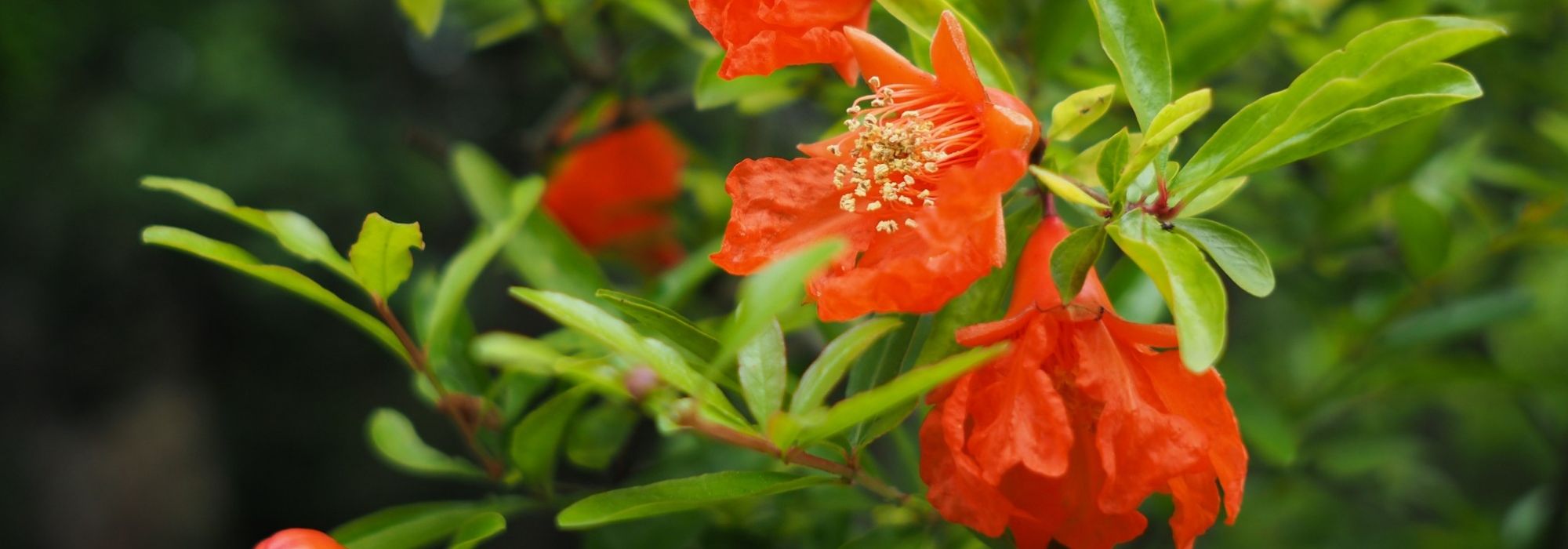
Flowering pomegranate: planting, pruning and maintaining
Contents
The Flowering Pomegranate, in a nutshell
- Pomegranate is a very ornamental bush with its fine, bright light green foliage that contrasts with its crumpled vermilion red or bright orange flowers, sometimes variegated, throughout the summer.
- The foliage declinates to beautiful orange-red hues in autumn before falling.
- Some cultivars produce small decorative purple or reddish fruits that are not edible, while others are dwarf varieties ideal for pot cultivation.
- Typical of the Mediterranean region, pomegranate enjoys warm, sunny locations but can tolerate frosts of around -12 to -15°C.
A word from our expert
Pomegranates have been the emblem of Mediterranean civilisations since the Egyptians, alongside the olive tree and the date palm. They form bushes reaching heights of 3 to 5 m that transform with age into small, stout trees with twisted trunks capable of living for two centuries.
The translucent, juicy, and sweet blood-red berries enveloped in a rather tough “shell” contribute to their success; however, with flowering pomegranates, it is the flowering that interests us. These cultivars feature often double flowers that resemble crumpled crepe paper flowers, bright orange, salmon, or flamed with white, which renew throughout the summer producing few or no fruits. Some cultivars produce small, very decorative fruits such as the varieties Fruits Violets, Nana, or Chico but with no culinary interest.
The deciduous bush with light bark displays fairly slender, slightly thorny branches, which are covered with attractive foliage that is elongated with rounded reddish tips in spring, intense apple green in summer before donning magnificent autumn hues.
This heat-loving plant, with a slow growth rate, is nevertheless quite hardy, tolerating temperatures down to -15°C, allowing it to be grown as far north as the Paris region. A sheltered, sunny position allows one to enjoy its brilliant flowering. It is very undemanding and is content with clayey, poor, and dry soil. The fruiting pomegranate requires a long, warm summer and good soil moisture to produce sweet pomegranates.
Description and Botany
Botanical data
- Latin name Punica granatum
- Family Lythraceae
- Common name flowering pomegranate
- Flowering from May to August
- Height between 0.30 and 5 m
- Exposure sun
- Soil type any loose soil that is rather cool, well-drained, even calcareous
- Hardiness Good (-12 to -15 °C)
The cradle of this fruiting bush, Punica granatum, is located from the northeast of Turkey to the north of India, probably passing through Iran. The Phoenicians are said to have brought it to North Africa during the founding of Carthage in 814 BC, but it was already depicted in the bas-reliefs of the Temple of Karnak and held an important place in Greek mythology, as well as in Christian, Jewish, and Muslim religions. In France, it often grows at the edges of vineyards or almond and olive orchards along the Mediterranean coast and in Corsica.
The genus Punica comprises two species, granatum and protopunica, the latter originating from South Asia, which belong to the family Punicaceae, now incorporated into the Lythraceae family.
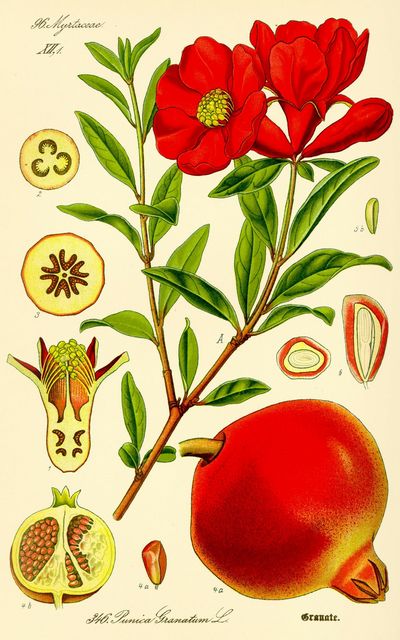
Punica granatum – botanical illustration
The pomegranate has a rather slow growth rate and a longevity of nearly 200 years. It forms a small stout tree or a bush with a bushy habit, reaching heights of 4 to 5 m and a spread of 3 m. The slender branches are slightly thorny and have a light beige-silver bark that is highlighted in winter by the absence of leaves. The rather late bud burst period towards the end of April gives rise to a lovely silhouette adorned with bronze to purple leaves that are opposite or whorled (grouped in threes or more). These turn bright green before declining into lovely orange and gold hues in autumn. The elongated lamina with a rounded tip, borne by a short reddish petiole, measures 3 to 8 cm in length.
Flowering occurs from May to August, often peaking in June and July, in the form of round orange buds, 1 cm in size, that unfold crumpled vermilion petals around a lush bouquet of yellow stamens and a central pistil. The calyx forms a kind of star-shaped, leathery shell, orange in colour, with a waxy appearance that eventually envelops the ovary and is found at the tip of the fruit. Flowering pomegranates have more generous flowers, often with double petals, sometimes variegated with white as seen in Legrelliae. Maxima Rubra produces large, very double flowers, loaded with crumpled petals whose texture resembles that of tissue paper, but they never produce fruit. The flowers of the dwarf variety Nana are simple, reduced to 3.5 cm in diameter. They emerge from a thick waxy-textured calyx that eventually forms a miniature edible pomegranate, whose skin, resembling leather, turns bronze, brown, to garnet red. The fruits persist on the bush throughout winter, providing decorative interest even after the leaves have fallen.
The pomegranate can be consumed raw or in the form of juice or syrup. The bark of pomegranates is used as a gargle for sore throats, as a powerful dewormer, and also as a dye plant.

Punica granatum ‘Madame Legrelliae’, evolution of flowering
Read also
When and how to prune pomegranate?The main varieties of flowering Pomegranates
Vigorous varieties for hedges or borders
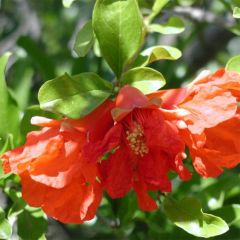
Punica granatum Maxima Rubra - Pomegranate
- Flowering time July to October
- Height at maturity 3,50 m
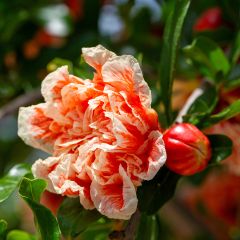
Punica granatum California Sunset - Pomegranate
- Flowering time July, August
- Height at maturity 3 m
Dwarf variety for pots
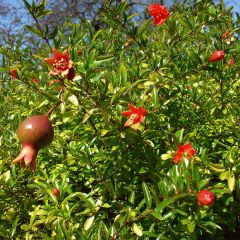
Punica granatum var. nana - Pomegranate
- Flowering time July to September
- Height at maturity 1 m
Discover other Punica - Pomegranate
View all →Available in 2 sizes
Available in 1 sizes
Available in 2 sizes
Available in 1 sizes
Available in 1 sizes
Available in 1 sizes
Available in 1 sizes
Available in 1 sizes
Available in 1 sizes
Available in 1 sizes
Young plantation
Where to plant the pomegranate?
The pomegranate is indifferent to the nature of the soil, it tolerates limestone as well as clayey, poor, stony, dry soils. Ensure good drainage if winters are cold and wet. If protected during its early years, the pomegranate becomes a much hardier bush than one might think, as evidenced by an old specimen that has been growing in the ground for over 20 years at the Botanical Garden of the University of Strasbourg in Alsace.
Choose a very sunny location, against a wall sheltered from north winds if you live outside the olive zone.
To produce fruit, it requires a long, hot, and dry summer, which is why its cultivation is mainly found in the area of the almond tree, olive tree, and fig tree.
When to plant?
If your winters are cold, plant the Punica after the last frosts, from April to May depending on the regions. Autumn planting is preferable in the Mediterranean zone to encourage rooting before the summer heat.
How to plant?
This plant is easy to grow.
- Soak the root ball in a bucket of water to thoroughly moisten it.
- Dig a deep, loose hole with a diameter three times wider than the root ball. Add a few handfuls of sand and gravel to ensure good drainage around the roots.
- Add manure or decomposed compost if the soil is sandy.
- Place the plant in the planting hole.
- Replace the soil and lightly firm it.
- Water.
- Mulch to maintain moisture during the summer, especially when the plant is young.
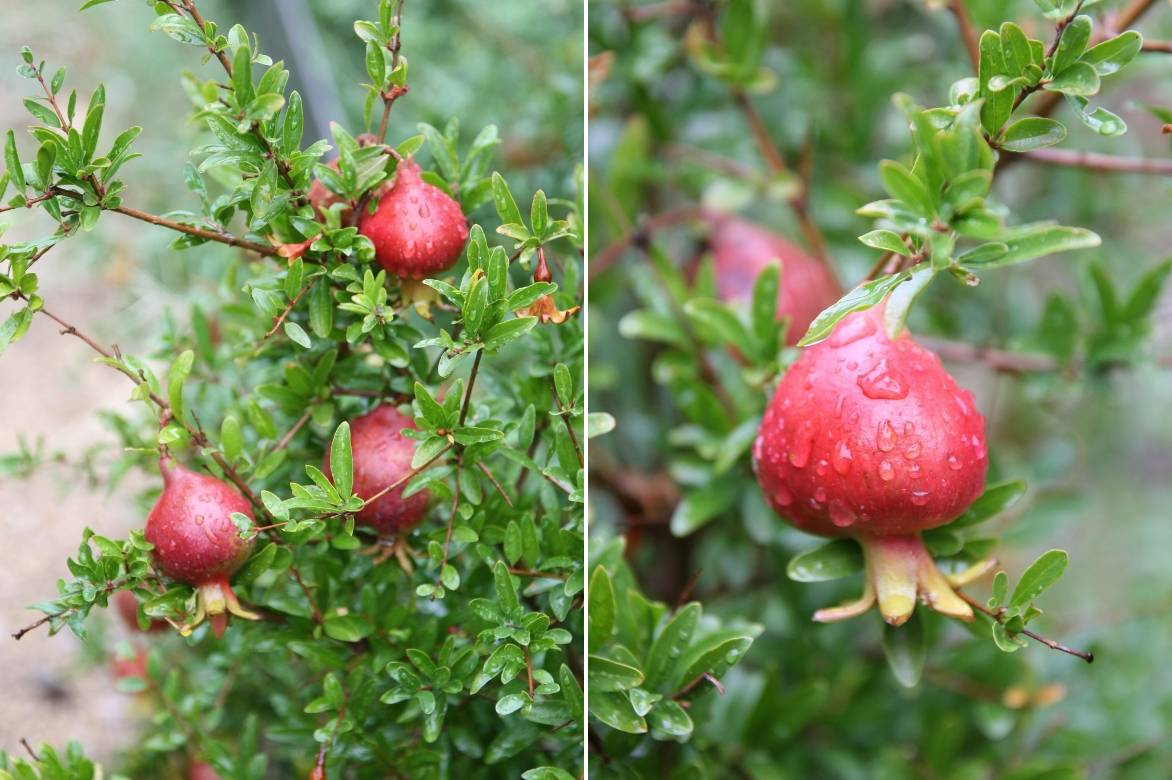
Punica granatum ‘Nana’ with fruit
Pruning and maintenance
Water regularly and deeply during the first summer to ensure the pomegranate establishes itself. Allow the soil to dry on the surface. In poor soil, you can maintain soil or substrate fertility with an application of manure, compost, or organic fertiliser in spring or autumn. In pots, add fertiliser for fruiting plants, such as “tomato” fertiliser, during the growing season.
Pomegranate Pruning
Allow the pomegranate to develop freely during the first few years of its life so that it establishes a deep root system and is ready to flower. You can then select 5-6 main branches or simply remove suckers, crossing branches, and dead wood. The slightly untidy bushy habit when young becomes slightly spreading and rounded when the flowering pomegranate is ready to bloom. Growth then slows down, making pruning very limited. Occasionally, shorten the branches to bring the flowering towards the centre. Carry out pruning in spring, at the start of the growing season, using pruning shears.
If you are growing the pomegranate in a pot or container to protect it from harsh winters, place it in a cool room during winter, even a dimly lit one, as long as the foliage is absent, to expose it to a slight cold period necessary for bud formation.
→ Learn more about pomegranate pruning in our tutorial: When and how to prune the pomegranate?
Multiplication : propagation by cuttings
Sowing pomegranate can be done with cultivars that produce fruit, but it takes nearly 5 years before it flowers, with no guarantee of obtaining the same flowers as the mother plant. The simplest method of propagating pomegranate is to extract suckers in autumn when they are present or to propagate by cuttings of branches.
Propagation by Cuttings
In November or February-March, prepare a well-tilled nursery bed by incorporating potting soil and sand.
- Take naked shoot tips that are 20-25 cm long.
- Insert them into the substrate, leaving only the last bud exposed.
- Extract the rooted young plants in the following spring or the year after to replant them in a nursery, leaving enough space around (25 cm) or in pots.
- Place them under a frame or in a protected location during the next 3 winters before moving them to their permanent position.
→ Learn more about pomegranate propagation in our tutorial!
Uses and associations
Pomegranate trees make beautiful subjects to plant in a pot or in a container depending on the size of the bush, knowing that growth slows with age. The Nana form can even be trained as bonsai. They can be planted alone or within a mass of bushes or perennials as their roots penetrate deeply into the soil, thus avoiding competition.
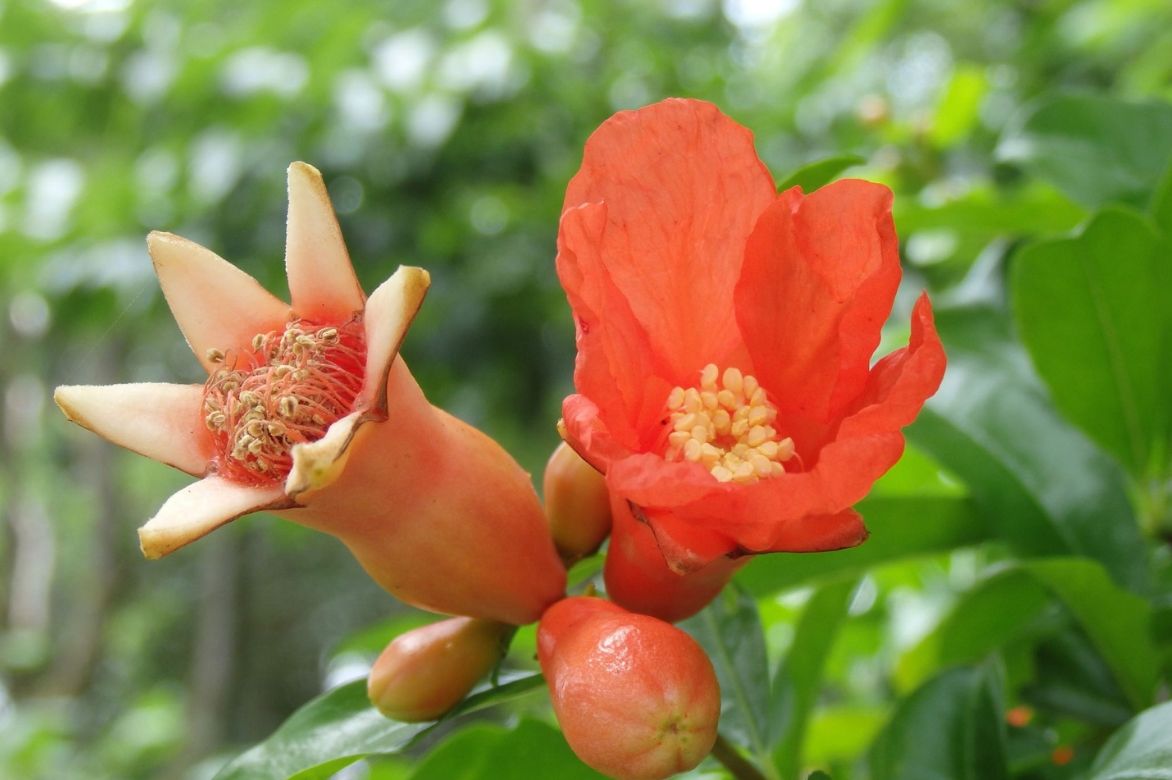
The dwarf pomegranate (Punica granatum ‘Nana’) is very floriferous and is well-suited for pot cultivation
In a hot and dry Mediterranean climate during summer, the pomegranate tree like Flore Plena forms rustic hedges alongside almond trees, olive trees, Pittosporum tobira, cistus, or laurel. This style of hedge requires no maintenance, tolerating both drought and minimal pruning, with healthy foliage where deciduous and evergreen plants mingle.
It can also be associated, as in the gardens of the Alhambra in Granada, with old bush or botanical roses such as Rosa chinensis Mutabilis, Rosa gallica versicolor, Rosa Jacques Cartier, or the Damask rose Rosa Ispahan.

An example of association: Punica granatum ‘Madame Legrelliae’, Rosa gallica ‘Versicolor’, Rosa ‘Jacques Cartier’ and Rosa chinensis ‘Mutabilis’
On the terrace, it will stand in a large pot, alongside other shrubs for terrace in Mediterranean style such as citrus trees, a Cape Plumbago, jasmine, a Solanum rantonetti, or a rose laurel. This method of cultivation allows them to be stored in a very bright location, protected from severe frosts if necessary between October and May.
→ Discover more association ideas with the pomegranate tree in our advice sheet!
Did you know?
The city of Granada, a crossroads of Arab and Andalusian civilisations, is home to the pomegranate tree brought by the Moors in the gardens of the Alhambra. This tree also thrived in the Hanging Gardens of Babylon, and the Romans, who discovered it in Carthage, named it the Apple of Carthage.
The pomegranate appears as a highly symbolic fruit from the High Egyptian, Greek Antiquity, and in the major Christian, Muslim, Buddhist, and Jewish religions. The first pomegranate tree is gifted to mankind by the goddess of love, Aphrodite. Hades gives a pomegranate to Persephone to keep her in the underworld as a symbol of fidelity. Among Muslims, the tree of paradise is the pomegranate. The juice symbolises the tears of Fatima, and the seeds represent those of the prophet. The date, the olive, and the pomegranate are among the fruits frequently mentioned in the Bible.
To go further
Discover our range of Flowering Pomegranates.
Our advice sheet: Diseases and parasitic issues of the pomegranate
- Subscribe!
- Contents
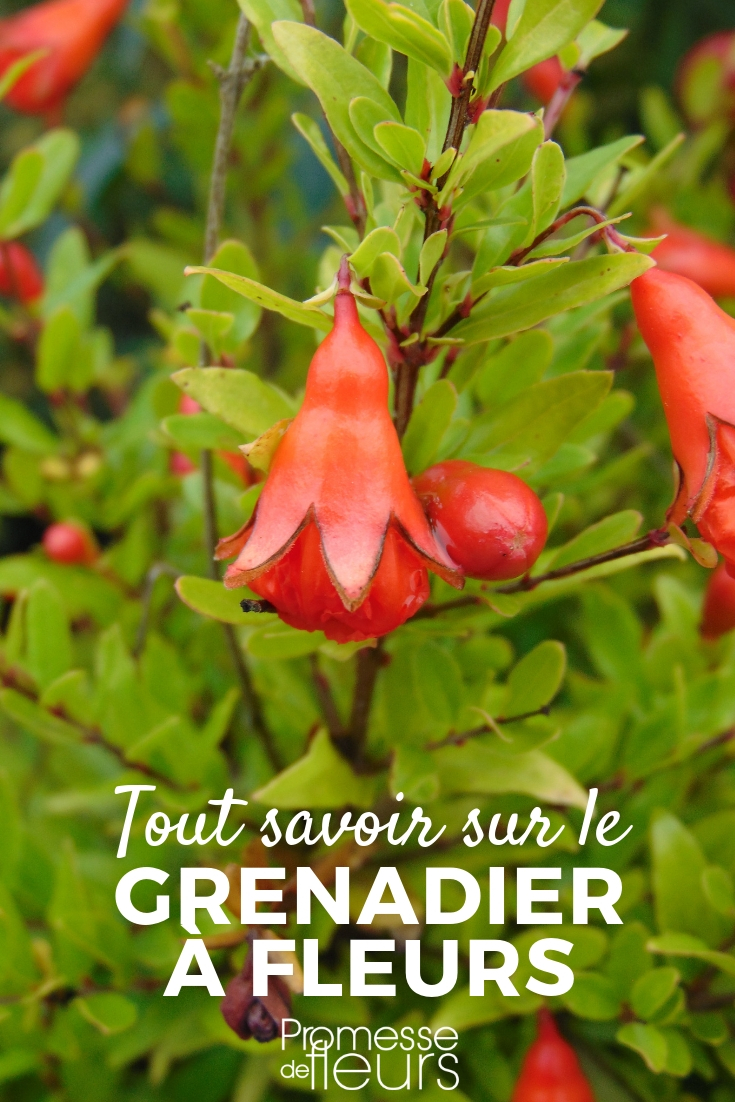



































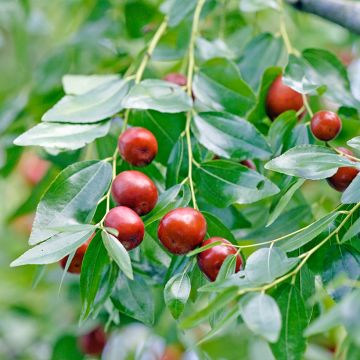
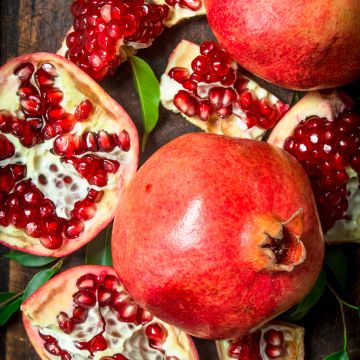

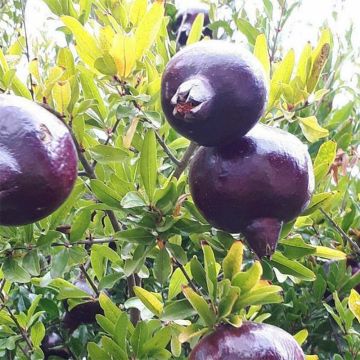
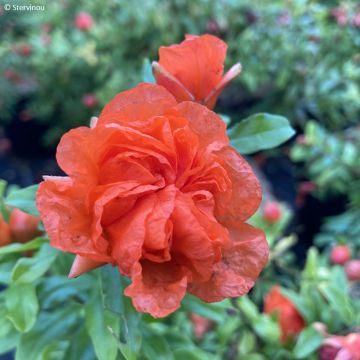

Comments